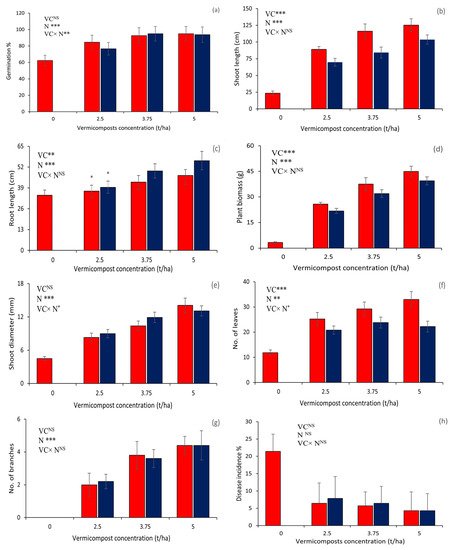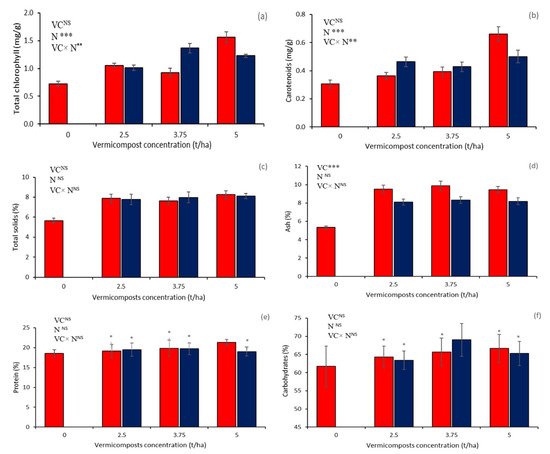Lantana (L. camara), which is acknowledged as one among the 100 most invasive and colonizing of the world’s weeds [1], has become a major threat to agriculture and forest ecosystems. [2,3].It has the ability to grow in widely varying environmental conditions [4,5], often forming large, impenetrable, thickets. This entry is to compare fertilizer-cum-pesticide effect of vermicomposts derived from cowdung and the toxic weed lantana. It has shown that vermicomposting transforms lantana into an organic fertilizer which is as benign and potent as vermicomposts based on cowdung and other manures are.
- allelopathy
- lantadene
- weeds control
- organic fertilizer
- vermicomposting
1. Background
The epigeic earthworm Eisenia foetida are used for vermicomposting lantana [[1]]]. Extensive investigations to characterize the lantana vermicompost (LVC) using Fourier transform infrared spectroscopy, thermal gravimetry, differential calorimetric analysis, gas chromatography, and scanning electron micrography (SEM) have revealed intense mineralization of the organic matter, degradation of lignocellulosic materials and polyphenols, reduction of toxic and allelopathic compounds (phenols and sesquiterpene lactones) in the course of lantana’s vermicomposting. SEM has reflected strong disaggregation of the organic matter content in LVC compared to the lantana matrices. Further, in a controlled study, Hussain et al. [[23]], have observed that LVC enhanced the germination of the seeds, and early growth of the seedlings of ladies finger, green gram (Vigna radiata) and cucumber (Cucumis sativus) when used at appropriate concentrations in soil. However, beyond certain level lantana vermicompost had shown adverse effects. This had raised apprehensions as to whether LVC behaves differently from cow-dung vermicompost (CDVC). It was, therefore, decided to compare the effects of LVC and CDVC under identical conditions. Accordingly, to carry out this study in which the effect of CDVC has been compared with that of lantana vermicompost on the growth, fruition and quality of the ladies finger produce.
2. Seed Germination

 and CDVC
and CDVC  on ladies fingerin terms of (a) germination success; (b) length of shoots; (c) length of roots; (d) plant biomass; (e) shoot diameter; (f) number of leaves; (g) number of branches; and (h) disease incidence. All the bars carry range of standard deviation. Bars topped with an asterisk indicate that the corresponding numbers do not differ significantly from the controls at p ≤ 0.05. N indicate the vermicompost treatments.
on ladies fingerin terms of (a) germination success; (b) length of shoots; (c) length of roots; (d) plant biomass; (e) shoot diameter; (f) number of leaves; (g) number of branches; and (h) disease incidence. All the bars carry range of standard deviation. Bars topped with an asterisk indicate that the corresponding numbers do not differ significantly from the controls at p ≤ 0.05. N indicate the vermicompost treatments.3. Plant Growth
| Parameters Observed | Type of VC | Vermicompost Concentrations (t/ha) | ANOVA | |||||
|---|---|---|---|---|---|---|---|---|
| 0 | 2.5 | 3.75 | 5 | Type of Vermicompost (VC) | Concentration of Vermicompost (N) | VC*N | ||
| Days to flower | LCVC | 52.7 ± 4.85 | 43.2 ± 2.30 | 39.0 ± 3.37 | 37.3 ± 2.41 | NS | *** | NS |
| CDVC | 43.3 ± 2.75 | 38.6 ± 2.84 | 39.3 ± 2.79 | |||||
| No. of flowers | LCVC | 2.9 ± 0.32 | 9.0 ± 1.05 | 16.3 ± 1.16 | 18.0 ± 2.16 | *** | *** | *** |
| CDVC | 8.3 ± 0.95 | 12.8 ± 1.32 | 10.1 ± 0.88 | |||||
| No. of pods | LCVC | 1.7 ± 0.48 | 6.2 ± 0.63 | 13.7 ± 1.06 | 16.2 ± 2.10 | *** | *** | *** |
| CDVC | 6.5 ± 0.53 | 10.8 ± 1.03 | 8.6 ± 0.52 | |||||
| Length of pods (cm) | LCVC | 7.1 ± 0.50 | 10.9 ± 1.11 | 11.6 ± 0.94 | 13.1 ± 1.34 | NS | ** | * |
| CDVC | 11.1 ± 0.98 | 11.7 ± 0.69 | 11.5 ± 1.10 | |||||
| Diameter of pods (mm) | LCVC | 11.4 ± 0.70 | 15.4 ± 1.04 | 16.0 ± 0.96 | 16.3 ± 0.72 | NS | * | NS |
| CDVC | 15.6 ± 0.77 | 16.7 ± 1.00 | 15.9 ± 1.21 | |||||
| Weight of pods/plant (g) | LCVC | 5.4 ± 0.50 | 91.9 ± 9.30 | 143.8 ± 8.47 | 170.5 ± 16.2 | *** | *** | *** |
| CDVC | 61.8 ± 6.20 | 101.6 ± 8.98 | 85.7 ± 8.72 | |||||
| Yield t/ha | LCVC | 0.5 ± 0.05 | 9.0 ± 0.91 | 14.1 ± 0.83 | 16.8 ± 1.60 | *** | *** | *** |
| CDVC | 6.1 ± 0.61 | 10.0 ± 0.88 | 8.4 ± 0.86 | |||||
| Percentage infected fruits | LCVC | 39.2 ± 12.39 | 9.3 ± 3.79 | 9.1 ± 5.42 | 8.0 ± 4.73 | NS | * | NS |
| CDVC | 13.4 ± 6.46 | 7.6 ± 2.77 | 7.6 ± 3.63 | |||||
43. Yield and Biochemical Aspects

 and CDVC
and CDVC  on ladies fingerin terms of (a) total chlorophyll in the leaves; (b) carotenoids in the leaves; (c) total solids; (d) ash; (e) protein in pods; and (f) carbohydrates in pods. All the bars carry range of standard deviation. Bars topped with an asterisk indicate that the corresponding numbers do not differ significantly from the controls at p ≤ 0.05. N indicate the vermicompost treatments.
on ladies fingerin terms of (a) total chlorophyll in the leaves; (b) carotenoids in the leaves; (c) total solids; (d) ash; (e) protein in pods; and (f) carbohydrates in pods. All the bars carry range of standard deviation. Bars topped with an asterisk indicate that the corresponding numbers do not differ significantly from the controls at p ≤ 0.05. N indicate the vermicompost treatments.54. Disease Incidence
References
- Hussain, N. Gainful Utilization of Toxic and Allelopathic Weeds for the Generation of Biofertilizer through Vermicomposting: An Assessment of the Fertilizer Value of the Resultant Vermicompost. Ph.D. Thesis, Pondicherry University, Puducherry, India, 2016; 175p
- Hussain, N.; Abbasi, T.; Abbasi, S.A. Vermicomposting eliminates the toxicity of Lantana (Lantana camara) and turns it into a plant friendly organic fertilizer. J. Hazard. Mater. 2015, 298, 46–57.Hussain, N.; Abbasi, S.A. Efficacy of the vermicomposts of different organic wastes as “clean” fertilizers: State-of-the-art. Sustainability 2018, 10, 1205.
- Hussain, N.; Abbasi, S.A. Efficacy of the vermicomposts of different organic wastes as “clean” fertilizers: State-of-the-art. Sustainability 2018, 10, 1205. Hussain, N.; Abbasi, T.; Abbasi, S.A. Vermicomposting eliminates the toxicity of Lantana (Lantana camara) and turns it into a plant friendly organic fertilizer. J. Hazard. Mater. 2015, 298, 46–57.
- Hilhorst, H.W.; Karssen, C.M. Effect of chemical environment on seed germination. In Seeds. The Ecology of Regeneration in Plants Communities; Cab International: Oxon, UK, 2000; pp. 293–309.
- Ievinsh, G. Vermicompost treatment differentially affects seed germination, seedling growth and physiological status of vegetable crop species. Plant Growth Regul. 2011, 65, 169–181.
- Edwards, C.A.; Norman, Q.A.; Sherman, R. Vermiculture Technology, Earthworms Organic Waste and Environmental Management; CRC Press: Boca Raton, FL, USA, 2011; pp. 220–231.
- Roberts, P.; Edwards, C.A.; Edwards-Jones, G.; Jones, D.L. Responses of common pot grown flower species to commercial plant growth media substituted with vermicomposts. Compost Sci. Util. 2007, 15, 159–166.
- Doan, T.T.; Henry-des-Tureaux, T.; Rumpel, C.; Janeau, J.L.; Jouquet, P. Impact of compost, vermicompost and biochar on soil fertility, maize yield and soil erosion in Northern Vietnam: A three-year mesocosm experiment. Sci. Total Environ. 2015, 514, 147–154.
- Edwards, C.A.; Arancon, N.Q.; Bennett, M.V.; Askar, A.; Keeney, G.; Little, B. Suppression of green peach aphid (Myzuspersicae) (Sulz.), citrus mealybug (Planococcuscitri), and two spotted spider mite (Tetranychusurticae) (Koch.) attacks on tomatoes and cucumbers by aqueous extracts from vermicomposts. Crop Prot. 2010, 29, 80–93.
